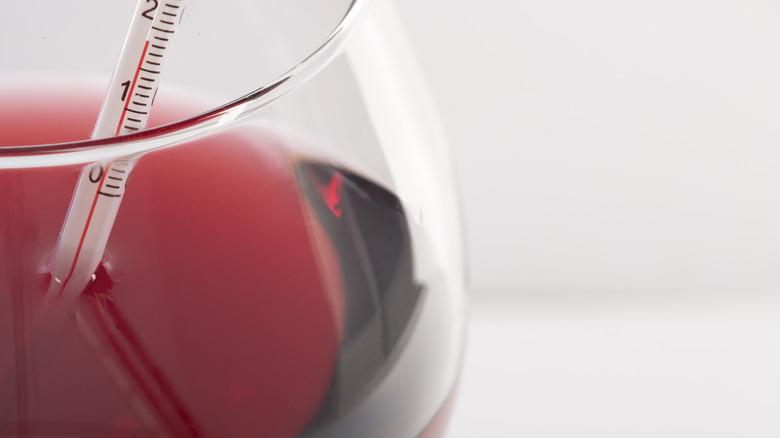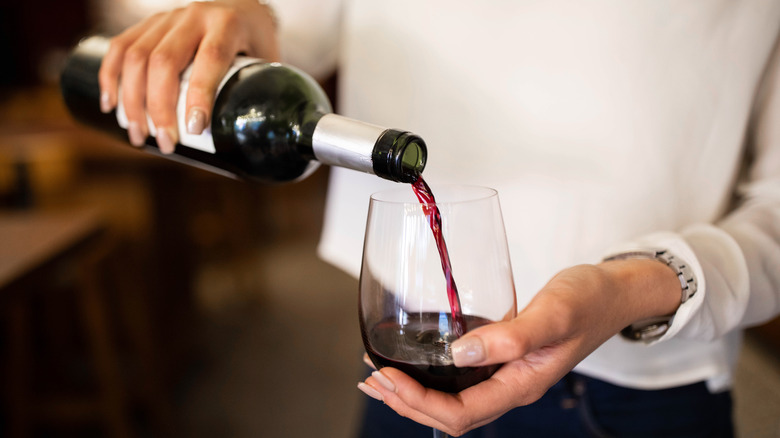The Right Temperatures To Serve Red And White Wines
Unlike most alcoholic drinks, wine requires some know-how to get the perfect glass. If you serve a chilled cabernet sauvignon, you'll get some funny looks and a bitter glass of wine. But rest assured, once you understand some simple basics, you'll be ready to handle any wine anytime. The quick and dirty of serving temperatures is to remember that red wines typically get served at room temperature while white wines are usually poured chilled. Of course, there's more to it than that, and preferences may differ, but if you're ever unsure and need to make a decision, it's a safe bet.
For those wondering how to measure the temperature of your wine, you have two options. Wine thermometers aren't expensive, and you can get much more precise. For everyone else, getting the exact temperature may not be all that important since getting in the ballpark will work just fine. If you're chilling wine, you'll want to do it while it's still in the unopened bottle. That way, the wine isn't getting exposed to the open air. If you have an opened bottle and need to chill it, use a wine stopper unless you plan on serving it in the next couple of hours.
Why wine temperature matters
It may seem like the temperature factor is overblown, but it really does matter. Not because you'll look like you know what you're doing (though you will), but because the taste of the wine changes drastically depending on its temperature. The colder the wine, the more the tannins — the compounds that give wine that gummy, bitter taste — will come to the forefront. Bold red wines are known for their tannins, which can be overpowering in a chilled bottle.
On the other hand, if you serve your wine too warm, the taste of alcohol will mostly be what you notice, which isn't what you want either. The unique flavor of that wine will be hard to detect, and even a good bottle will seem no better than a bargain one. This is particularly true of white wines, where the flavors are more subtle than the bold reds.
In reality, the right temperature for the wine will be specific to that exact wine bottle. Some wine bottles will print the ideal temperature right on the label for you, which removes a lot of the guesswork. If it doesn't, just remember that light-body wines should be colder than full-bodied wines, and sweeter wines are served colder than dry. Ultimately it comes down to preference; if you want to get more conscious about what your preferences are, consider getting a wine journal and keeping track of what wines you like at what temperatures.
What temperature should white wine be?
As we said, white wines are generally served chilled, between 45 and 50 degrees Fahrenheit. The coldest wine you'll have will be sparkling white wines like prosecco at 45 degrees. Sweeter white wines like Pinot Gris and Sauvignon Blanc are good anywhere in that 45 to 50 range. Bolder white wines like Chardonnay should be served at the upper end of 50 degrees.
It's important to remember that your refrigerator keeps your food at around 35 degrees Fahrenheit, which is quite a bit lower than what you will want to serve your wine at. One option would be to keep your wine out of the fridge until you're ready to serve it, then stick it in the refrigerator for 30 minutes. If you've been storing the wine in the fridge, consider pulling it out beforehand so it can warm back up enough that you get all the flavor the wine wants to give you. An ice bucket will help you keep the wine chilled if you plan to have it out for more than half an hour.
What temperature should red wine be?
Red wine is a little more straightforward since most vintages will taste just fine at room temperature. That being said, if you really want to get with the times, you should serve red wine slightly chilled. That means somewhere between 59 and 65 degrees Fahrenheit, depending on the type. Similar to white wines, the bolder the red, the higher the serving temperature.
Zinfandel and Chianti are considered light reds and should be served at 59 degrees. Pinot Noir is best a little warmer at 61 degrees; then you get the bold reds like Cabernet Sauvignon and Syrah up at 63 and 64 degrees, respectively. For most people, room temperature isn't sitting at 59, which means you'll have to get creative to knock off those few degrees. A flash in the fridge should do the trick — you can put light reds in for around 15 minutes, while bolder reds should only go in for roughly 10 minutes. It's not a good idea to stick red wine in an ice bucket, because it'll get too cold.
The proper storage temperature for wine
There's a big difference between serving temperature and storage temperature. Just because a Bordeaux is served at 64 degrees doesn't mean you should keep it there for a year. If you have a wine cellar, you've already solved the problem, but for the rest of us, wine is best kept at a static 55 degrees Fahrenheit regardless of what type it is.
Fluctuations in temperature should be avoided as best you can. Too hot, and it turns into something like vinegar. Too cold, and you'll wake up in the middle of the night with your corks popping out of the bottles because the wine froze and expanded. A wine cooler is a great way to store wine because it gives you complete control, but if you aren't looking to spend that kind of cash, finding a cool pantry and laying bottles on their side will work fine. And while the refrigerator is not an ideal long-term storage solution, you won't do it much harm if you polish it off in a reasonable amount of time.




